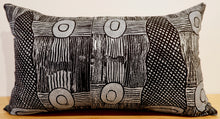Coussin ‘Fishtrap and Billabong / Nasse à poissons et Billabong’ de Janet Marawarr - Noir, 30x50cm
IDAIA x Babbarra
Prix régulier
€59.00
Solde
Housse de coussin d'art 30 x 50 cm.
Tissu: Linogravure sur tissu en coton, imprimée à la main avec des encres écologiques par les femmes artistes du Bàbbarra Women's Centre dans la communauté aborigène de Maningrida en Terre d'Arnhem.
Tissu uni en lin naturel au dos.
Déhoussable avec fermeture éclair.
Cousu main dans un atelier parisien.
Lavage à froid en machine possible.
Le positionnement des motifs sur l’objet est variable.
Chaque coussin est une pièce unique.
Signification du design tissu :
Le peuple Kuninjku fabriquent traditionnellement deux sortes de pièges à poissons coniques : Le mandjabu, plus grand et plus résistant, est réalisé à partir d'une vigne solide et durable appelée milil, et le le manylik mandjabu, plus léger, est fait à partir d’une herbe appelée manylik.
Le piège mandjabu est utilisé dans les courants des ruisseaux pour capturer les gros poissons tandis que le manylik sert à attraper les petits poissons et les crevettes dans les ruisseaux d'eau douce.
Autrefois, seuls les hommes étaient impliqués dans la fabrication des nasses, alors que les enfants rampaient souvent à l'intérieur et participaient à l'ouvrage. Pour confectionner le mandjabu, les tisserands récoltent tout d'abord le milil (vigne burney, Malaisia scandens) puis le trempent toute une nuit dans de l’'eau pour le rendre souple. Ils le tissent pour réaliser des anneaux à l’intérieur afin de conserver la forme du piège à poisson. Ils fabriquent également des ficelles à partir de l'écorce de burdaga (kurrajong) pour attacher les anneaux de bardainy (hibiscus) et l'extrémité conique de la nasse. Le travail est délicat et il faut parfois trois ou quatre semaines pour construire un piège.
Les Aborigènes peuvent aussi utiliser d’autres pièges à poissons (kunkarlewabe) au milieu desquels ils placent le mandjabu. Ils élaborent par ailleurs des barrages faits de petits bâtons, de roches, de boue et d’herbe pour empêcher les poissons de passer.
Ils attrapent ainsi une grande variété de poissons tels que des barramundi rajarra, des barramundi d'eau douce (« ngaldadmurrng »), des poissons-chat noirs d'eau douce (buliya), des bonefish (« an-guwirrpiya ») ou encore des bars (« dalakan »).
En savoir plus sur la collection
Compléter avec la garniture de coussin correspondante
***
Cushion ‘Fishtrap and Billabong / Nasse à poissons et Billabong’ by Janet Marawarr
Art cushion cover 30 x 50 cm.
Fabric: Linocut on black cotton fabric, hand-printed with ecological inks by the women artists of the Bàbbarra Women's Centre in the Aboriginal community of Maningrida in Arnhem Land.
Backed with natural linen fabric.
Removable cover with zipper.
Hand sewn in a Parisian workshop.
Cold machine wash possible.
Explanations for the fabric design:
Kuninjku people traditionally make two sorts of conical fish traps. One is called mandjabu and is made from a strong, durable vine called milil, and a smaller one is called manylik mandjabu, and made from the grass manylik.
The mandjabu conical fish trap is bigger and stronger and used in tidal reaches of creeks to catch large fish. The smaller, lighter manylik trap is used in freshwater flowing creeks to catch smaller fish and freshwater prawns.
In earlier times, only men were involved in the construction of the large fish traps, but children would often crawl inside and assist. To make mandjabu, weavers firstly harvest milil (burney vine, Malaisia scandens) and put it in water overnight to make it soft. Then they start weaving it; they make rings for the inside to keep the fish trap’s shape. People also make string from the bark of burdaga (kurrajong) to attach the bardainy (hibiscus) rings and to tie the conical end of the fish trap. It’s hard work and it can take three or four weeks to make a fish trap.
People also use fish-net fences called kunkarlewabe. They would put the kunkarlewabe across rivers and creeks. In the middle they would place the mandjabu. They also used small things like sticks, rocks, mud and grass to block the fish from going through.
This way we would catch fish such as saltwater barramundi rajarra, ngaldadmurrng (freshwater barramundi), small black freshwater catfish (buliya), bonefish (an-guwirrpiya), and sand bass (dalakan) in the mandjabu.
Learn more about the collection
Complete with corresponding insert






